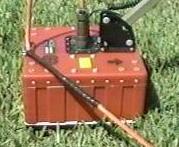

400 MHz Antenna and SIR-2 Digital Control Unit

Basic Operating Principles
Ground penetrating radar is a nondestructive geophysical method that produces a continuous cross-sectional profile or record of subsurface features, without drilling, probing, or digging. Ground penetrating radar (GPR) profiles are used for evaluating the location and depth of buried objects and to investigate the presence and continuity of natural subsurface conditions and features.
Ground penetrating radar operates by transmitting pulses of ultra high frequency radio waves (microwave electromagnetic energy) down into the ground through a transducer or antenna. The transmitted energy is reflected from various buried objects or distinct contacts between different earth materials. The antenna then receives the reflected waves and stores them in the digital control unit.


400 MHz Antenna and SIR-2 Digital Control Unit
The ground penetratiing radar antenna (transducer) is pulled along the ground by hand or behind a vehicle.
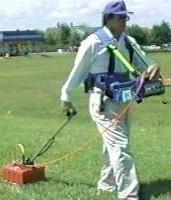
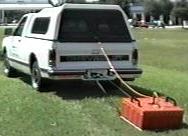
Hand-towed GPR Survey and Vehicle-towed GPR survey
When the transmitted signal enters the ground, it contacts objects or subsurface strata with different electrical conductivities and dielectric constants. Part of the ground penetrating radar waves reflect off of the object or interface; while the rest of the waves pass through to the next interface.
The reflected signals return to the antenna, pass through the antenna, and are received by the digital control unit. The control unit registers the reflections against two-way travel time in nanoseconds and then amplifies the signals. The output signal voltage peaks are plotted on the ground penetrating radar profile as different color bands by the digital control unit.
For each reflected wave, the radar signal changes polarity twice. These polarity changes produce three bands on the radar profile for each interface contacted by the radar wave.
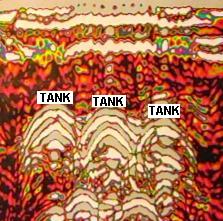
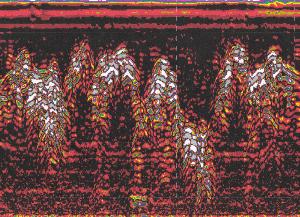
Ground penetrating radar waves can reach depths up to 100 feet (30 meters) in low conductivity materials such as dry sand or granite. Clays, shale, and other high conductivity materials, may attenuate or absorb GPR signals, greatly decreasing the depth of penetration to 3 feet (1 meter) or less.
The depth of penetration is also determined by the GPR antenna used. Antennas with low frequencies of from 25 to 200 MHz obtain subsurface reflections from deeper depths (about 30 to 100 feet or more), but have low resolution. These low frequency antennas are used for investigating the geology of a site, such as for locating sinkholes or fractures, and to locate large, deep buried objects.
Antennas with higher frequencies of from 300 to 1,000 MHz obtain reflections from shallow depths (0 to about 30 feet), and have high resolution. These high frequency antennas are used to investigate surface soils and to locate small or large, shallow buried objects and rebar in concrete.
GeoModel, Inc. conducts ground penetrating radar surveys using a SIR-2 digital control unit and various antennas with frequencies ranging from 25 to 1,000 MHz. The GeoModel, Inc. principals have over 40 years of combined experience and conduct GPR surveys worldwide, at low cost.
GeoModel, Inc. conducts surveys in every state.
Contact us to check the availability of a crew in your state.
Click on your state below:

e-mail: ![]() geomodel@geomodel.com
geomodel@geomodel.com
[Back to Top of page]